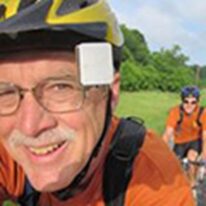Destination: Washington—Following the Foothills Trail
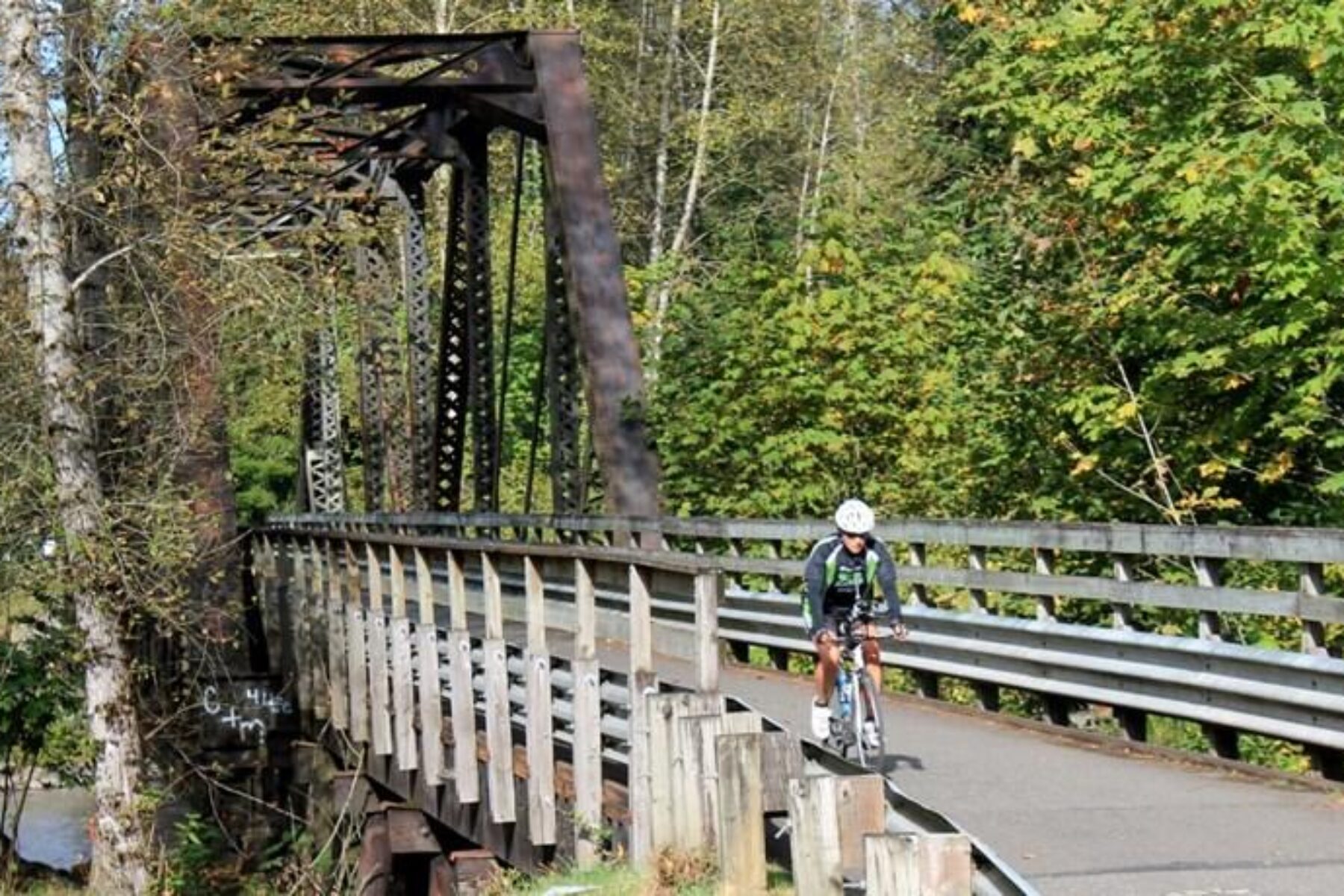
This destination article was originally published in the Spring/Summer 2015 issue of Rails to Trails magazine. It’s been published here in an edited format.
There’s a spot on the Foothills Trail in western Washington where I always slow down. It’s not a sudden steep climb or dicey patch of gravel that causes me to feather my bike brakes on the outskirts of Orting. It’s the imposing and ever-changing view of glacier-capped Mount Rainier seemingly emerging at the end of the trail. One time the sun may be striking the craggy face of the 14,410-foot-elevation volcano in a way I’ve never seen previously; another time a flying-saucer-shaped lenticular cloud may be floating above the summit.
A short distance ahead, the Carbon River rushes past the trail in a wide channel choked with rocks and sediment scoured away by the mountain’s lowest glacier. More often than not, I’ll stop, lean my bike against the back of a bench and have a seat.
Tracing the Trail
This paved segment of the Foothills Trail is a good trail for exercise, as it runs uninterrupted for 15 miles with an imperceptible 400 feet of elevation gain. In places like this, where the forest closes in and the river runs wild, the trail also offers day-trippers quiet spots to pause for reflection.
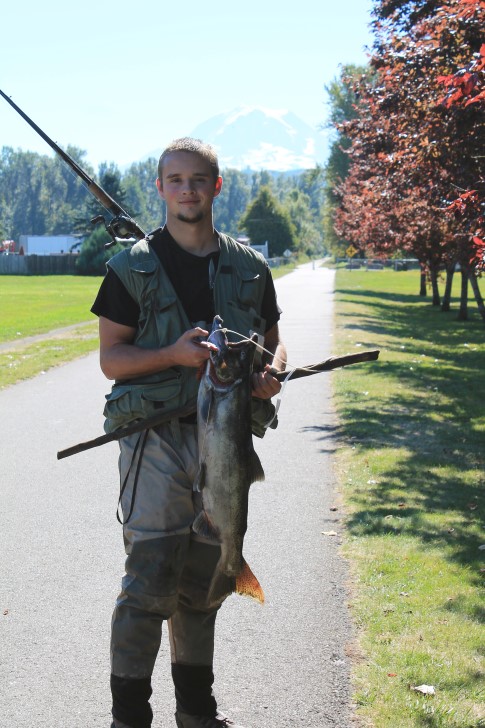
The entire trail rolls for 30 miles, with some gaps, along river valleys at the base of the Cascade Range. It passes through farmland and forest along the abandoned corridor of the Northern Pacific Railway that began serving the port of Tacoma in the early 1870s.
Other unattached paved sections—each 2 to 4 miles long—are located to the north in Enumclaw and Buckley and trace the old train route toward St. Paul, Minnesota.
Adventuresome hikers and mountain bikers may want to follow the dirt single-track segment that runs about 4 miles, connecting the historic towns of Wilkeson and Carbonado on the railroad’s southern branch to the coalfields at the base of Mount Rainier. Another loopy segment of paved rail-trail less than 2 miles long, in an area known as Cascade Junction, crosses creeks and ravines on four bridges. (Unfortunately, this segment—normally accessible only by a frequently flooded path that starts at a “Proceed at Your Own Risk” sign—was just made more difficult to access due to bridge damage on the segment’s northern end.)
On the main 12-foot asphalt trail, you’ll find cyclists on training rides, walkers stretching their legs, moms and dads pushing strollers, and dog owners exercising their pets. They use words such as clean, safe, scenic and friendly to describe the trail and its vibe.
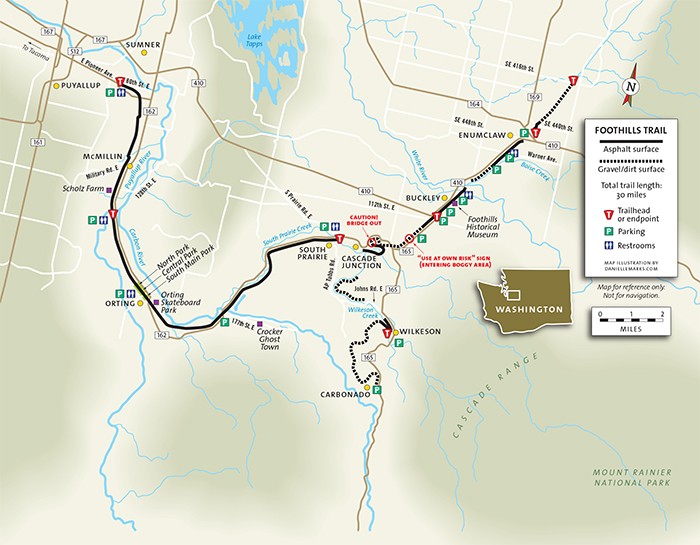
He thought the trail would be a healthy thing for his patients and everyone around here. He could see the good it would do for people’s health.
Father of the Foothills
Thirty-some years ago, the late Douglas Tait, a Buckley physician, was looking for a way to keep his clientele active and healthy when he witnessed Burlington Northern Railroad crews pulling up the abandoned tracks of the old Northern Pacific. Doc Tait thought the rail corridor would make a great trail for Pierce and southern King counties.
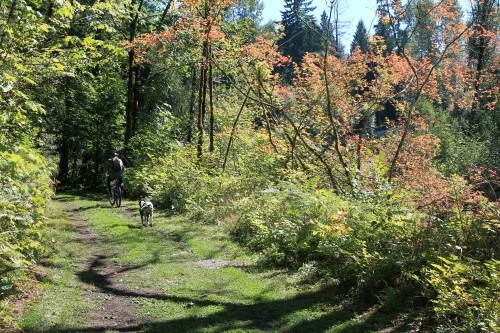
When I asked Foothills Rails-to-Trails Coalition President Buzz Grant about the trail’s origins, he called Doc Tait the “father of the trail.” It was Tait who came up with the idea, helped form the coalition and hosted the first meetings in his office with like-minded residents to move the trail concept forward. “He thought the trail would be a healthy thing for his patients and everyone around here,” said Grant. “He could see the good it would do for people’s health.”
The longest section of completed trail runs from the East Puyallup Trailhead, where I start this bike ride, eastward toward South Prairie. A small blue sign just down the trail catches my eye. It reads, “If you hear the lahar sirens, move quickly to high ground (at least 50 feet off the valley floor).” Lahars are mudflows from volcanos, and geologists say the broad, flat valley here was formed by a series of flows that swept down from Mount Rainier. The most recent buried this valley under 20 feet of mud some 600 years ago.
Those ancient mudflows made rich topsoil, which early settlers used for farming. Eventually they focused on the cut flower and bulb trades, carpeting the entire valley in yellow daffodils by the 1920s. The new industry sparked an annual daffodil festival and parade that continues today. Housing, commercial development and the dairy industry have now covered those daffodil fields, although a sculpture honoring the daffodil still stands at a crossroads in Orting.
RELATED: The Minuteman Bikeway (A Revolution on Two Wheels)
Good Neighbor to Ma and Pa
About 4 miles down the trail, near McMillin, a gravel driveway leads through a trailside field of rhubarb to Scholz Farm. There’s a produce market as well as shaded picnic tables. I grab a bottled juice from the refrigerator and talk to Allen Scholz, the fourth generation of his family to work the land here.
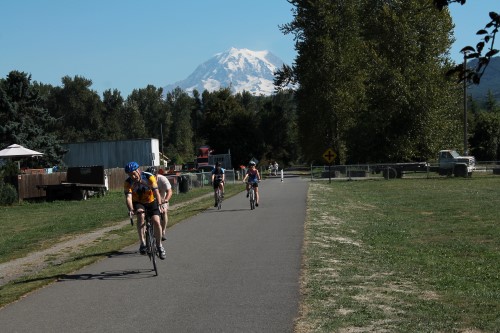
Allen admits he wasn’t thrilled to hear in the 1990s that a trail would replace the railroad. He was concerned about trespassers. After the trail opened in 2005, he changed his tune. His produce market business picked up as trail users stopped for nourishment. He began selling juice, dried fruit and other snacks to this health-conscious crowd. Many returned in their cars for larger purchases and became regular customers. “I’d say the trail’s a good neighbor,” he tells me.
Back on the trail, I arrive at the McMillin Trailhead in about a mile and cross a trestle spanning the Puyallup River, which runs chalky white as it carries glacier melt from Mount Rainier. Just down the trail, housing subdivisions, schools and commercial development spring up as I head into Orting. First settled in 1854, today the town of 6,700 is considered a bedroom community for the sprawling Tacoma-Seattle area.
Although I’m barely 7 miles down the trail, the aromas from burger joints and cafés tickle my taste buds. Craving carbs, I choose the Orting Bakery, located across State Route 162 from the city park. Munching on a giant peanut butter cookie, I scan photos depicting the area’s coalmining, logging and agricultural heritage, and the role played by the Northern Pacific Railway in getting those goods to market.
Majestic Trail
Pedaling out of town past a bike skills park, I come to the spot that rewards trail users with awe-inspiring views of Rainier—weather permitting. This section can be crowded with people, including fishermen in the fall. The anglers walk from parking lots in town to fish for salmon, which are returning from the ocean to spawn in their native creeks and rivers.
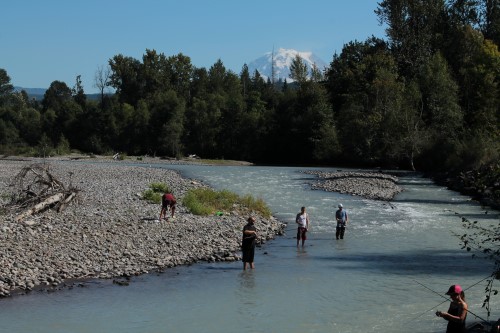
Another trestle crosses the Carbon River near the ghost town of Crocker about 3 miles past Orting, and the trail follows the tamer South Prairie Creek. I pass a fenced pasture nearby that sometimes holds bison, though only a solitary emu patrols the land today.
Passing through a low railroad cut, the trail emerges into farmland and arrives at the small, aptly named town of South Prairie. A trailhead and barrier mark the current end of the trail, as the railroad corridor enters an area that’s been contested by private property owners. Pierce County Parks and Recreation Planner Joseph Coppo says some former railroad property beyond the “Do Not Enter” sign has been acquired for the trail, while remaining tracts face condemnation. Meanwhile, the county is seeking a state parks grant to develop paved trail connections east and north to completed segments in Buckley and Cascade Junction. The trail coalition’s Buzz Grant says a long-range goal calls for improving rail-trail connections south almost to the Carbon River entrance at Mount Rainier National Park.
Trailside Coffee Break
Everyone who travels the trail to South Prairie recommends Trailside Connections Espresso. The drive-through coffee kiosk sits on the main road, but the owners cleared out a blackberry thicket at the trail’s edge, built two shelters with picnic tables and added a walkway and walk-up window for trail-users.
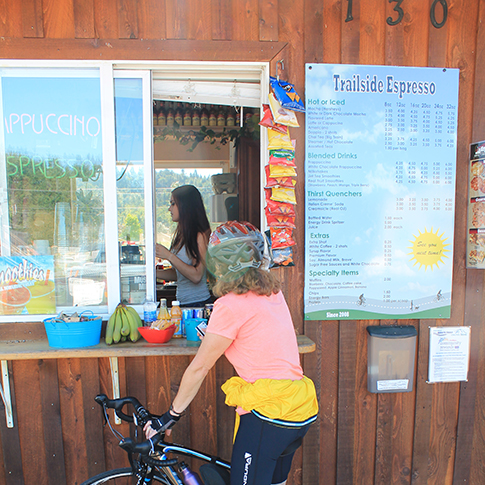
While I sip an iced Americano here, the barista tells me that she gets more business from cyclists than motorists in the summertime and on many weekends.
Fortified by caffeine for my return trip, I stop for a scenic photo along the Carbon River. Five-year-old twins Marissa and Colby are chucking some pebbles into the river, their bikes lying nearby. Parents Nick and Jessica from Puyallup say they used to visit the trail for walks when their kids rode on training wheels. Once the twins graduated to two wheels, Mom and Dad couldn’t keep up anymore and bought their own bicycles. “They got us going,” Jessica says.
If Doc Tait were around today, he’d probably like to hear how new generations continue discovering the Foothills Trail.

Donate
Everyone deserves access to safe ways to walk, bike, and be active outdoors.
